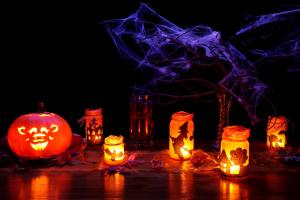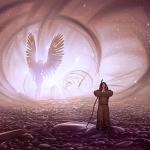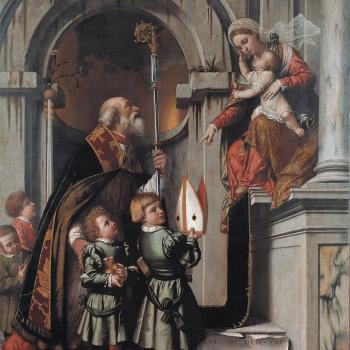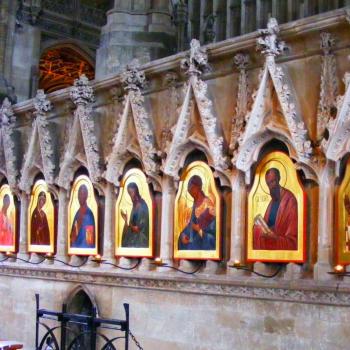
Traditionally, Christians used the symbolism of night and day to express the difference between the time before the incarnation and the time after it. That is, Jesus Christ, the Sun of Righteousness, brought light into the world, brought in, as it were, a new day. The light of Christ shines brightly in and through the saints. All those who are a part of the kingdom of God will have their own share of grace, their own share of the light of Christ, and so will experience its glory for themselves. Before the advent of the incarnation, it was night; but even then, we find there were saints, there were those infused with grace. Just as the night is not without its own light, as we see in the night dark the light of the moon and the stars, so God was at work with humanity before the incarnation, preparing the world for it, but all the light which was found was nothing in comparison to what would be after the incarnation. Thus, we should not ignore the grace which was found before the incarnation, but we should see it in relation to the incarnation itself. This is why evening services, such as Vespers, often reflected this sentiment, as their readings came from texts written before the incarnations. There is much grace experienced in these services, but they pale in comparison to the Divine Liturgy which presents to us the incarnate Lord in communion. It is also this sentiment which we can seen expressed in the Western celebration of All Saints Day. The night before All Saints, Halloween, represents the darkness which came before the incarnation, while All Saints itself represents the glory of the kingdom of God as the light of the Sun of Righteousness shines in and through all those who have become infused with the light of grace.
This is one of the many reasons why I like the secular celebration of Halloween. Despite itself, it has not entirely lost the religious element which inspired it. It reflects upon the darkness which is to be had outside of the grace of Christ. It shows us the horrors which we can produce or experience. It reminds us that, despite all our best efforts, all our best ideals, that life can be full of suffering, that the darkness, wherever it exists, in whatever form it establishes for itself, can and will strike at us with its malice. But even then, we also learn it can be contained; where there is light, where there is charity, where there is a way to overcome the darkness and its malevolence. Pumpkins shine bright with candles, chasing away the monsters which wish us ill; benevolent men and women stand by the doors, giving goodies to those who come, forestalling or preventing evil. Tricks are overturned by treats. Those who come in the shape of little monsters are mollified by the charity of those they come to meet. The demonic powers are put in check. Grace wins, even in the darkness.
The Byzantine Catholic celebration of All Saints is the Sunday After Pentecost. It presents to us the fruits of Pentecost. We are all called to be Saints, and indeed, we can all become Saints. Christ sent the Holy Spirit into the world. Through it, we can be made holy. The light of grace spreads across the world rendering those who are touched by it holy. The West, when it changed its date for All Saints, took upon itself another meaning with it. It still presents to us the glory of Pentecost, the glory of the work of the Holy Spirit in the world, but it connects it with various other eschatological themes. Summer has come to an end, the earth and what is on it is dying. Death makes itself known to all of us. All those who have come before us, all those who have died, are brought back to mind. We are therefore encouraged to also bring to mind all those who have been touched by grace and made holy, so that we can be reminded that in and through such grace, death is not the end but only a point of transition. The dead can and will find new life in Christ. They can receive the glory of the kingdom of God and so experience the great and eternal day of the Lord. How do they get there? By following Christ through death. The darkness embraced them. They all died.
Horror is tied with the mystery of death. With Halloween we are reminded that all of us shall experience the greatest power of the darkness and all the horror it can bring to us. We shall all go through and experience the mystery of death. We remember the saints by remembering the day they became saints, that is, the day they died; so when we reflect upon them, we reflect upon the universal power of death. They could not avoid it, and so neither shall we. Thus, on the night before All Saints, the night of Halloween, the universal power and horror of death itself is made manifest. And just as we must embrace the cross and die to the self, there is value in engaging the darkness through sign and symbol, so that we can prepare ourselves for our own death. We know one day it shall come. We prepare for it so that it does not become a thing of sorrow or despair. Rather, we are encouraged to remember that death has been conquered and overcome; its power has been dispelled, its horror is limited. We shall go through it so that we can arise at the dawn of the great and eternal day of the Lord.
It is fitting, therefore, that in the West, the celebration of All Saints comes with it all kinds of symbols of horror. Halloween reminds us of the ultimate horror which we shall all face, the horror of death, but it does so in such a way that, just as Christ conquered death through death, we conquer the horror of the night through our embrace of it. Of course, we must be careful. We must not allow ourselves to be possessed by the darkness and all the monsters within it; rather, we allow ourselves to experience it so that we can bring the light of grace to it. Then, we shall find Christ is working through that grace, expelling the horror of the night for us, so that we can then experience the full realization of the kingdom of God, joining in with all the saints who have come before us.
Halloween has all kinds of morbid imagery and symbols associated with it, but that is because it reminds of us all that was in the darkness before the time of Christ, of all that Christ has conquered for us. It presents to us the final revelation of the darkness and its ephemeral nature. It has been put under control. It no longer has to dominate us with its horrors.
Stay in touch! Like A Little Bit of Nothing on Facebook.
If you liked what you read, please consider sharing it with your friends and family!












